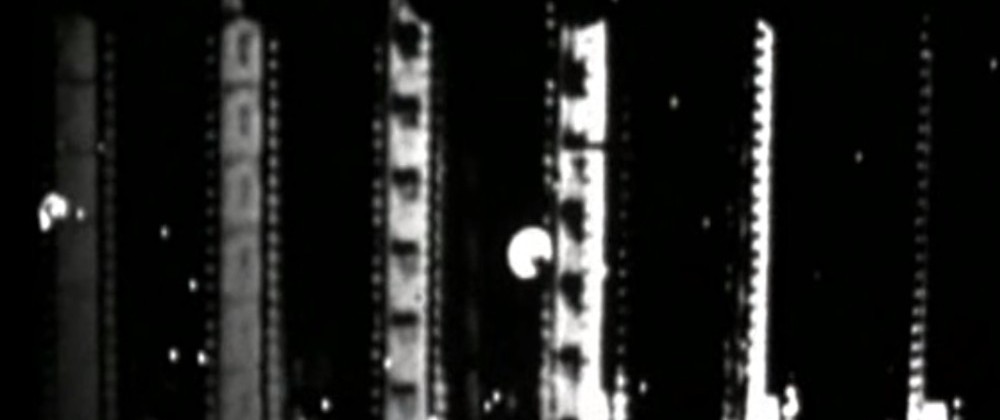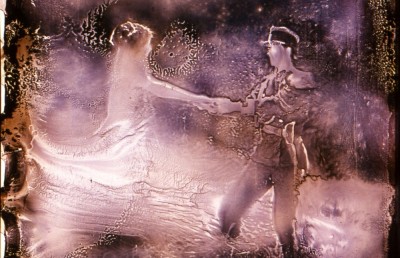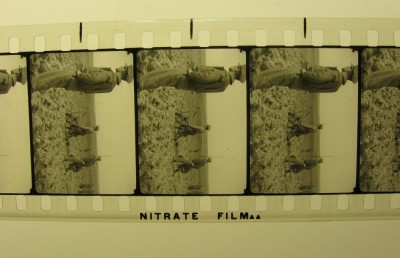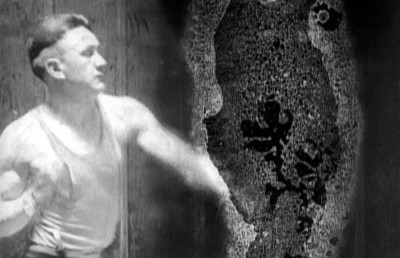Around the Films of Bill Morrison
Thinking in the Ruins

The “imaginary of ruins” can designate a vast array of practices and aesthetics. The expression encapsulates many meanings, genres, and phenomenas. One can speak, for instance, of the ruins in the décor of post-war cinema (Italian neo-realism, the German “rubble films”), but also of Hollywood apocalypse films, which can serve, anachronistically, as prophecies for disasters to come (September 11th), but more generally as symptoms of fears or of fantasies of self-annihilation (The Day After Tomorrow).
But there is another was of considering “ruins” in cinema, and that is to consider the ruin of the film itself: the physical decay of the film strip. There are, of course, a great number of institutional consequences to the decomposition of film, but it has also been seized as an aesthetic opening. Many filmmakers have in fact made films out of broken fragments found in film archives, working on the poetic, plastic and historical value of decomposed film.
Amongst them, the recent films of New York filmmaker Bill Morrison have been concerned with the particular struggle between film and its material medium. There is a conflict between the image and matter which ruins the narrative of the original, twisted by the gnawing power of time, but which at the same time produces a paradoxical tale of ruins, born out of this double resistance of the filmic image and its material.
The standard 35mm film (institutionalised in 1908-1909) was, up until 1950, composed of a strip of nitrate cellulose, a layer of gelatine, and an emulsion of silver salts. In 1951, this highly unstable organic material was forbidden and was replaced by a synthetic film (called safety film) made of an acetate base. There have also been films made of polyester (in order to replace the acetate films, which have turned out to succumb to the much dreaded “vinegar syndrome”). Nitrate film is today stored in isolated temperature-controlled bunkers; the rolls can only be manipulated by highly qualified professionals, and the public projection of a nitrate print is illegal. Nitrate film is not only highly flammable, it also deteriorates at an alarming speed if it is not preserved in a controlled environment (if the film reaches a high degree of degradation, at 40 degrees Celsius, it explodes and burns). The decay of nitrate film is a well known phenomena and its first effects obviously worried archivists and film restorers well before fascinating filmmakers and artists.
The disappearance of film, not by technical obsolescence, but by an organic-chemical law, is as inevitable as the erosion of stones or the aging of bodies. You can slow it down, but you cannot prevent it.
It is a beautiful and tragic paradox that the art of film, which captures the movement and the flow of life, has had to grapple with its material mortality more than any other artistic medium. Film has always conjugated the flow of industrial products and technical reproducibility, often with hyperbolic discourses on immortality which led one of the first observers of the cinematograph, in 1898, to say, “soon, death will cease to be absolute,” and André Bazin, at the end of the 1940’s, to claim that cinema resolved once and for all Man’s “mummy complex:” the desire to perpetuate oneself through time.
We could say that it is natural, in fact normal, that since cinema captures and formulates the flow of life, it would manifest the passage of time on its very material. It is this idea that Jean-Louis Schefer defends: the material base of film possesses an entropic desire to reach a “zero degree,” a state of pulp, of ash – and fatally that is what it becomes… in the meantime, and against its own temporal logic, its ‘ruin’ produces images.
The interest that certain filmmakers, since the 1980’s, have taken in the materiality of decayed film and found fragments of early cinema (Pathé, Edison, Lumière Brothers, Gaumont, newsreel films, scientific, exploration, amateur and home movie) appeared at the same time as discourses on the ‘agony’ of film. The ‘agony’ being trying to survive the digital revolution, in effect opposing the material trace, the quasi-tactile impression of light on film, to the immaterial flux of digital encoding or the magnetic signal of the video strip.
Strangely enough, while these media ruptures that have directly and indirectly affected cinema in the 1980’s and 1990’s were occurring, cinema was becoming institutionalized and imbedded as cultural heritage. Cinema became the privileged witness of the history and memory of the Century (we can think of Godard’s Histoire(s) du cinema, but more generally of laws and measures that were voted for the protection of cinematographic patrimony, of new funds given to national archives, cinematheques, many restoration projects, etc.). This status given to film seems to have been as important as the loss that cinema suffered (specialists estimate that about 80% of cinema’s first 30 years has disappeared). It is also during those years (1980’s-1990’s) that cinema studies became increasingly interested with early cinema (the works of André Gaudreault, Tom Gunning, William Urrichio, Laurent Mannonni, Michel Marie, Giuliana Bruno, etc.), and that we began seeing the release of a great number of early films on DVD.
It is within this vast and complex context of an interest for “rediscovered cinema” that has seen the appearance of artistic practices that have explored the possibilities of a “poetic archaeology of cinema,” between archival film and experimental cinema: it is probably in this fashion that we can best describe the works of Angela Ricci-Lucchi and Yervant Gianikian (From the Pole to the Equator), Peter Delpeut (Lyrical Nitrate, Diva Dolorosa), Gustav Deutsch (Film ist), Bill Morrison (Decasia, The Film of Her, The Mesmerist, Light is Calling), or the fascinating photographic works of Éric Rondepierre (Précis de décomposition, Moires).
All these works tend to extract these fragments of films from their particular narratives, to detour them in a way, in order to introduce them into another dramaturgy, that of time, of the work of time. These artists are interested in what happens to the film–to the chances of its organic decay, and to the new possibilities of meaning and of imagery often stunning that the corrosion of these surviving, or agonizing images can create.
These images are often the stage of a strange fight between a concurrent series of forces, the image and the matter of the image, tension between impression and decomposition, between history and nature, and between narration and ruination. These films are agonizing, precisely because they oscillate between life and death, on the threshold between survival and disappearance. There is a conflict between the image and the base in which it is held – and on which it does not always take hold.
Bill Morrison has, since the early 1990’s, elaborated multimedia shows in collaboration with the Ridge Theater for which he creates films. Most of these are made of footage found in institutional archives, or simply discovered under various circumstances. Most of these films are today presented as autonomous works, and all of them represent, for various reasons, major accomplishments.
The rule of Morrison’s early films (Footprints, Death Train, etc.) consisted in pushing to its limits certain great principles of montage – attraction and intellectual, to use Eisenstein’s terms – in order to produce chains of meaning: train/film/joyride/fair in Death Train, evolution of man/primitive cinema, exploration films/scientific films in Footprints, etc.
With The Film of Her (1996), his path seemed to have taken a new turn. This slightly fictionalized documentary on the paper print collection of the Library of Congress in Washington, triggered a reflection on the loss/reappearance of films and a change in his next films: slow down his editing, dilate durations, and proceed by blocks of time (Trinity, made in 2000, is a major turning point in that regard). It is in early 2000 that he became directly interested in corroded film and began exploring the visual possibilities of decayed material. Morrison’s wish is to bring viewer’s into a state of reflection on human mortality, and for which the decayed film serves as a memento (we will rot like the films).
The Film of Her
Decasia was finished in 2002. It is made up various black and white decayed fragments from the early days of cinema to the 1920’s (with only one or two exceptions, from the 50’s). These images construct a sumptuous allegory of survival, of the cycle of creation and destruction. Initially, the film accompanied a multimedia event featuring Michael Gordon’s symphony, that took place in Switzerland, with the Basel Sinfonietta Orchestra. Since its premiere, and because of the increasing interest and curiosity the film has managed to create, it seems that the film has now taken center stage, and that the symphony now accompanies the images.
This fusion, born out of the encounter of extraordinary talents, has produced a remarkable film that reinvents in many ways the art of found footage, while recognizing the debt it owes to a long tradition, going from Joseph Cornell’s Rose Hobart, to Ken Jacobs Tom, Tom, the Piper’s Son, to Al Razutis’ Origins of Film. It also seems that Brakhage’s hand-painted films provide a perceptual-aesthetic model that is very close to the visual play of degradation that Decasia foregrounds.
Each frame of Decasia was stretch-printed two or three times, slowing down the images and enabling the eye to capture the passing of the film strip and the stains, marks, and holes that have attacked it, making this struggle between image and matter a fascinating experimental laboratory. The most elaborate and ironic example of this appears near the middle of Decasia, when we see a boxer fighting a storm of decay that is gnawing away at the film. This sequence –whose discovery seems to have been a “decisive moment” in Morrison’s creative process– illustrates almost too literally this conflict between the “first film” (a boxer is training) and the junk: the visual noise that time has deposited on the strip of film. But is it simply a question of noise? Is the message simply made unreadable or opaque? If we begin to play the game of the image, these marks, these visual wastes become fully part of the image: what we see is in fact a boxer trying to untangle himself out of an ectoplasmic substance, an unstable and shredded bubbling blob. It’s almost a sci-fi scenario. The image, as Éric Rondepierre would say, plays with its own destruction, as a new image appears, in the interplay between the decomposition and its decomposed figure.
This type of “dialectical-image” obviously interferes with the narrative impulse and original function of the sequence, taken from a 1927 newsreel. [1] The figure of the boxer was a favoured figure in early cinema –one needs to simply think of Étienne-Jules Marey and Eadweard Muybridge, Edison and Lumière, on up to Chaplin– probably because fighting scenes wedded the movement of bodies in action (it’s the “monstrative” dimension) to a dramatic tension (it’s the nascent notion of narration). In the case here, what we have is an ordinary training session that is metamorphosized, through the interplay of decomposition, into an epic struggle between a boxer and an uncanny enemy, that ends up swallowing our worthy fighter in the interval between two shots. We could also say that this decayed image recycles the classical theme of the vanitas, the vain struggle of Man against Death –which makes this image even more ghostly. It is, it seems, this theme that guided Morrison’s research and that presided over its construction. Each image seems to be suspended between the creation or the origin of the world and its fascinating and irreversible destruction.
Morrison’s Light is Calling
Georg Simmel, in his 1907 essay, “The Ruins,” analyses how an architectural structure sooner or later enters into a dialectic struggle with nature. Nature avenges the violence perpetrated against it by producing its own work, which deconstructs the work of Man. He writes: “the fascination of ruins rests upon its capacity to show the work of Man almost like the work of nature”. [2] Ruins produce a new unity by breaking the unity of the building conceived by human intention, under the pressure of chance and by integrating it into its natural décor. In a ruined edifice is inscribed a free play of vital and antagonistic forces, between past and present, between intention and chance, and who’s opposed energies produce an aesthetic unity.
In the case that interests me, we could say that the ruin institutes an interval of time and indicates a play of forces between the first impression, the index of a presence (a boxer is standing in front of a camera), and the bio-chemical decay, that are as many traces of the passage of time.
Like in many other “fictions of ruins,” there is no immediacy between the trace and its meaning, there is rather an opaqueness of signification that makes us aware of the work of time, and that invite us to think from that working – that one should conceive at the same time as writing and un-working. These tortured images, these surviving-images, deconstruct the ordered time of narration, and appear in this limit of readability that make the images appear as images, between indexicality and trace without meaning, between actualised presence of the past and a complete enigma of time. A “fiction of ruins” is built through all these: a tale without characters, that composes itself through fragments, from the event of its own agonising matter, that appears at the point of their vanishing.
The images of Morrison’s films place us in front of a double tracing of time, one slow, the other ephemeral. They should invite us to pursue a reflection on this new “melancholia of ruins” at a time when, as Marc Augé recently put it, ruins, as notion and phenomena, are slowly disappearing from our Western cities, out of a “lack of time” (faute de temps): we are condemned to produce waste, not remnants of the past. This is maybe what the ruins of cinema, patiently and violently, are tracing, whilst disappearing.
Endnotes
[1] Bill Morrison does not provide, in his film, any specific information concerning the source material that he used (I thank him for providing me this information). For a more detailed account on the issue of identifications and referencing, I refer you to my interview with Bill Morrison.
[2] George Simmel, « Les ruines : un essai d’esthétique », in La parure et autres essais, Paris, Éditions de la maison des sciences de l’homme, coll. « Philia », p. 113. My translation.













